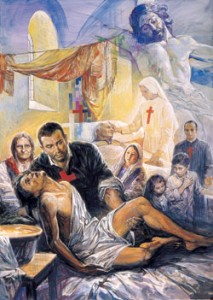Sr. Camillus de Lellis
From the book RITRATTI DI SANTI by Antonio Sicari (Jaca Book)
Health Care
During the sixteenth century the sick were in the hands of mercenaries; some were criminals forced to do such jobs; others did this because they had no other way of making a living. A chronicler of the sixteenth century provides us with the following vision of the wards of hospitals: ‘They were forced…to use, so to speak, the scum of the world, that is to say ministers who were ignorant, outlaws or investigated for some crime, forced to stay for penance or punishment inside those places…It was at least certain that the dying poor would be there for three whole days, struggling and suffering in their pitiable agonies without someone saying to them the least word of consolation or comfort’.
These are not exaggerations because we can encounter similar things in other hospitals. When Camillus and his religious began to work in the Major Hospital of Milan (the ‘Ca’ granda’) they found the places where the sick people lay in such a state that Camillus thought that they were a ‘cause of death’. ‘God knows how many of them die because of this state of those dirty, fetid and muddy places!’
A Director at the Hospital of St. James, Rome
 Once again at the ‘Incurables’, Camillus was by now known for his conversion. Very quickly they appointed him to be the Master of the House, that is to say the person directly responsible for the economic and organisational side of things. He began to put things in order. Day and night he used to appear when nobody expected him, appealing to, rebuking and forcing each person to do their work and to do it well. He controlled the purchases, argued with the tradesmen, and sent back the consignments of bad goods. Without stopping he exhorted the servants and explained to them: ‘The sick poor are the eyes and heart of God and…what you did to these poor people you did to God Himself’.
Once again at the ‘Incurables’, Camillus was by now known for his conversion. Very quickly they appointed him to be the Master of the House, that is to say the person directly responsible for the economic and organisational side of things. He began to put things in order. Day and night he used to appear when nobody expected him, appealing to, rebuking and forcing each person to do their work and to do it well. He controlled the purchases, argued with the tradesmen, and sent back the consignments of bad goods. Without stopping he exhorted the servants and explained to them: ‘The sick poor are the eyes and heart of God and…what you did to these poor people you did to God Himself’.
New Men for a New Care
One fixed thought obsessed him: to replace all of the mercenaries with people ready to be with the sick only out of love. He wanted to have with him people ‘not for pay but voluntarily and out of love for God serve the sick with that lovingness that mothers have for their own sick children’. This was the project. Manifestly resolved in his intentions, he immediately gave rise to concern. There were those who feared that interests and habits would be called into question; others suspected that Camillus would end up by taking control of the hospital; and yet others – although moved by good intentions – thought that the project was unrealistic. Opposed in their plans, Camillus and his companions left the Hospital of the ‘Incurables’ where they were by now no longer wanted and found themselves in a very poor little house where they were short of blankets and during the night had to take it in turns to cover themselves. Their free activity in the great Roman Hospital of the Holy Spirit began in this way.
At the Hospital of the Holy Spirit
This was the glorious Hospitium Apostolorum, the hospital wanted directly by Pope Innocent III in the thirteenth century and entrusted by him to the religious of the Holy Spirit. Sixtus IV, the Pope of the Sistine chapel, renewed the hospital with such magnificence that he retrieved at least at the level of ideals its original value: ‘Cult of love due to Christ, God and man, sick in the poor’. Unfortunately, together with the great faith of the Church, in this hospital, as well, the misery of this earth was visible.
Men, indeed, did not deserve that solemn structure; the problem of mercenaries was similar to that of other hospitals, the problems of hygiene and of dirt notably humiliated that splendour, and the hoped-for voluntary work was changed into disorder.
Continues – The heritage–














Camillians on Facebook
Camillians on Twitter
Camillians on Instagram